#an: there's a hanakotoba reference there
Explore tagged Tumblr posts
Photo

“This refined gothic coat with a lily-esque silhouette is themed after ‘the curse of love.’ The belts represent the shackles of a heart bound by unrequited yearning.” (2022)
#hishima sakazuki#hishiba#sketches#my art#bravadoting#fun fact most of the TWEWY cast has birthday flower language#some Cony x Cony item descriptions reference it (hanakotoba)#Hishima's flower is the Black Lily and I drew him in the namesake coat#Although Hishima's love is requited the meaning does play into the mutual perception he and Shiba had that the other had moved on#Does not help from Hishima's POV that he sees Kubo occupying his old role (as Shiba's righthand man)
13 notes
·
View notes
Text
If I'm with you, I'm happy

'If I'm with you, I'm happy' - the meaning of the yellow hyacinth, the flower that inspired me to make this in the first place ♡ /Print will be on the shop tomorrow / edit: print here! <3
Hanakotoba notes:
Hyacinth (general) - 悲しみを越えた愛 ‘kanashimi o koeta ai’ love that transcends sadness
Yellow hyacinth - あなたとなら幸せ ‘anata to nara shiawase’ if I’m with you I’m happy, 勝負 'shoubu' battle/match
Blue hyacinth - 変わらぬ愛 ‘kawaranu ai’ unchanging love
White hyacinth - 控えめな愛らしいさ 'hikaemena airashisa' reserved love, 心静かな愛 'kokoroshizukana ai' tranquil love
Purple hyacinth - 悲しみ 'kanashimi' / 悲哀 'hiai' sadness/grief/sorrow, 初恋の直向きさ ‘hatsukoi no hitamukisa‘ devotion of first love
Pink hyacinth - スポーツ sports, ゲーム games, しとやかなかわいらしさ 'shitoyakana kawairashisa' graceful cuteness (shitoyaka 'graceful' can also be translated as 'refined', 'modest', 'gentle', 'quiet' etc.)
Red hyacinths also exist but I didn't add them here as they didn't fit (meaning is 'envy')
Margaret - 真実の愛 ‘shinjitsu no ai’ true love, 信頼 ‘shinrai’ trust. There's also 恋占い koiuranai 'love fortune-telling' which I think may refer to that 'he loves me, he loves me not' game.
Twisted trees also have some nice symbolism to them (in general). What I'm about to say isn't something I found anywhere in particular, just my own thoughts about them. Disregarding the *hahaha* about the not-straight tree implications that I'm sure will be lost to no one single tumblr resident whatsoever- generally twisted trees are that way because of the winds they withstood (I mean there are other reasons too of course...). They're beautiful in their perseverance towards life. Life may have shaped you a certain way, with the good and the bad - and the shape you've taken is to be appreciated in its beauty... of simply being, and existing, and persevering despite all.
Link to the Hanakotoba site (set up so you can switch between JP and (auto)translation - keep in mind autotranslation is not perfect, in fact there are a few differences I corrected above) : hyacinths and margarets You can also search some words on jisho to see additional meanings, there are quite a few... I chose the ones I deemed most apt. Unfortunately you can't copy-paste the Japanese, I use the rikaikun extension for the kanji I don't know (which is most of them I gotta be honest). I have the JP keyboard installed and I just retype it to post it here haha.
#ace attorney#narumitsu#miles edgeworth#phoenix wright#wrightworth#gyakuten saiban#periwinkla#I hope I didn't mistype anything it's midnight and I'm quite sleepy.... hahaha#also if you're wondering about the lack of leaves on the tree?#for that there isn't really a reason beyond needing there to be space for the eye to breathe#but I suppose you could say it's as bald as the pining goofs will be soon enough-
449 notes
·
View notes
Text
Card Set Hanakotoba

Recently I was discussing with my lovely friend @istoleyourboat about the meanings behind the flowers in this new card set, and I felt the urge to chronicle them somewhere! I thought you guys might get a kick out of it, too, so this seemed as good a place as any to put it.
So without further ado...
1. Hanako-kun - Queen of the Night
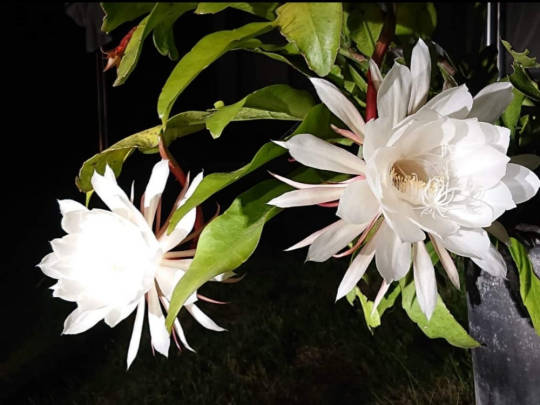
The Queen of the Night (月下美人) is a cactus flower that blooms just once a year for a single night. Because of this, the most heavily associated meanings with the flower are "transient beauty", "fleeting love," and "the urge to see someone just once."
The short-lived life of this flower feels quite fitting for our ghosty boy! I also like how the flower looks both beautiful and unsettling...all around a fantastic choice by AidaIro.
2. Nene Yashiro - Strawberry Blossoms

If you have paid attention to the Hanakotoba in TBHK before, then Nene being associated with strawberries should be nothing new to you. Regardless, the prevalent Hanakotoba for Strawberry Blossoms (イチゴ) are "love," "innocence," and "you make me happy."
The "you make me happy" one makes me want to kick my feet around and squeal a little. Isn't that cute!? I also feel the strawberry is especially fitting for Nene because it seems like something she would grow in her Gardening Club.
3. Kou - Clivia

Otherwise known by the names Bush Lily or Natal Lily, the Hanakotoba for Clivia (君子蘭) are "sincere," "noble" and "good-hearted."
I think this all fits very nicely with our resident good boy Kou, hm?
4. Teru - Bird of Paradise
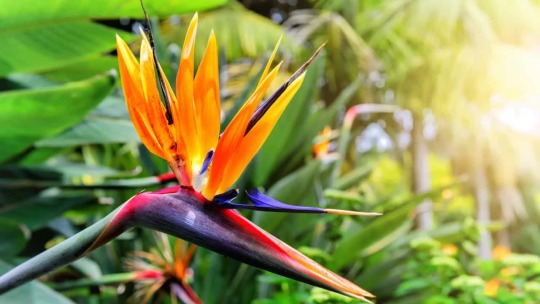
The Bird of Paradise (ストレリチア) symbolizes "faithfulness," "magnificence," "a bright future" and "superficial love."
Even at a glance this flower really pops out at you, making it a great fit for the ever-impressive Teru. I really, really love this choice!!
5. Sakura - Hellebore
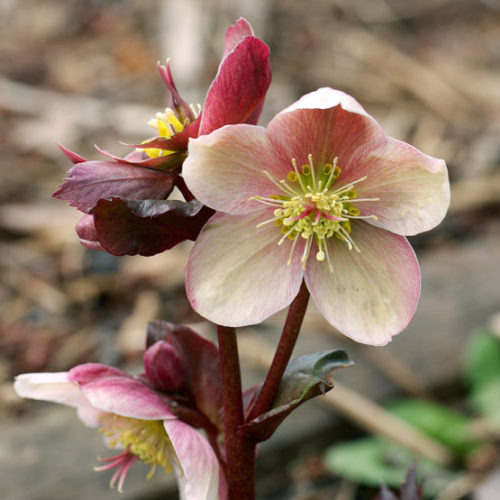
Otherwise known as the Christmas Rose, the Hellebore (クリスマスローズ) represents "reminiscence," "never forget me" and "notice my woes."
The way this beautiful flower seems to cast its head down makes it look almost sad. I suppose that's why it has such pitiful meanings associated with it!
6. Natsuhiko - King Protea
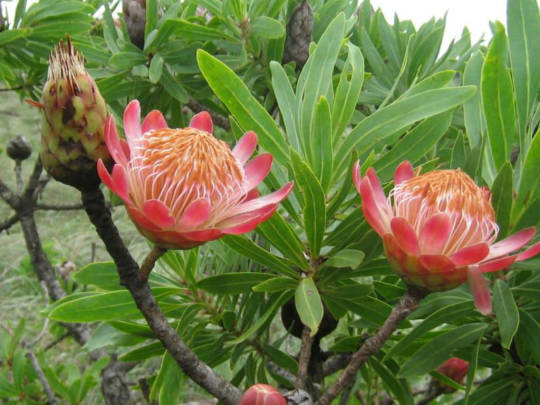
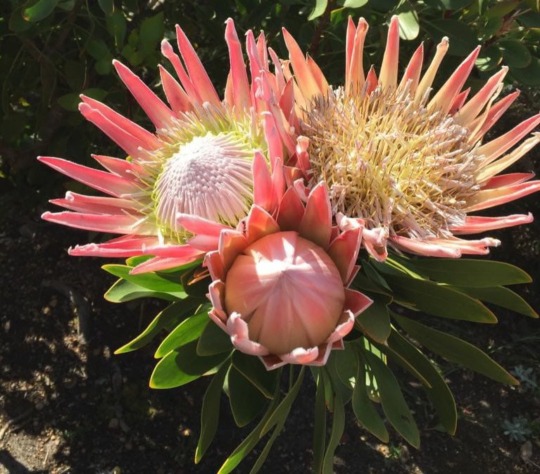
King Protea (キングプロテア), also known as the Sugarbush, symbolizes "strength," "courage," "resilience," and "a king's quality."
If you notice, Natsuhiko always has a little crown-shaped tuft hidden in his hair, so AidaIro associating Natsuhiko with a flower that references royalty pleases me. There's still a lot of mystery surrounding him, but we can at least confirm that Natsuhiko is, indeed, strong and resilient.
(Edit: the flower might be a crysanthemum (菊) instead! Crysanthemums represent the imperial family of Japan, so the association with royalty is still present. The red crysanthemum is a symbol of love.)
7. Akane - Ivy
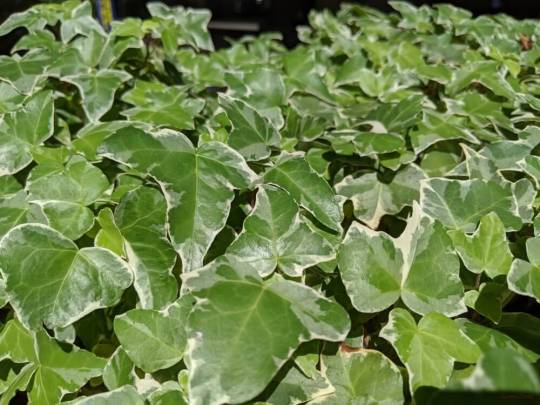
The plain, non-flowering ivy stands out in stark contrast to the other plants here, but that's because the hanakotoba for it is just that good. Ivy (ヘデラ) means "everlasting love," "I take this feeling to the afterlife," "faithfulness", and "marriage."
Like, if that doesn't scream Akane, I don't know what does.
8. Aoi - Hydrangea

Again, if you've been paying attention to Hanakotoba in the series, this will not be the first time you've seen Aoi paired with hydrangea. Regardless, hydrangea (アジサイ) represents "enduring love," "mystique," and "fickleness."
The hydrangea is also associated with rejection, more specifically the coldness of a person who rejects the romantic advances of another. It's just such a perfect Aoi flower, there's no wonder AidaIro is so attached to it.
💐🌸🌼🌻🌷🌹🥀🌺
Thank you for reading till the end! And I urge you to look up these flowers yourself and see if you can find any meaning to them I may have missed. You might find something brilliant that I completely overlooked!
#tbhk#jshk#toilet bound hanako kun#hanakotoba#aoi akane#akane aoi#hanako kun#nene yashiro#amane yugi#natsuhiko hyuuga#sakura nanamine#teru minamoto#kou minamoto
327 notes
·
View notes
Text

New collaboration with Loft & Amnibus was announced for Digimon Adventure!
Details about exact merch will follow soon, but the tweet states that the concept was decided by keeping the idea of 25th Anniversary in focus but the art itself is flower + wedding outfit themed. The collab will start in June which is considered a good month for brides in Japan and so we see many wedding themed anime illustrations get released during this time every year.
Now it is time for another certified Ayushi breakdown 🫡

Taichi and Agumon are seen holding Edelweiss, with a pattern of the flower drawn beautifully on Taichi's shirt as well. Edelweiss in Japanese Language of Flowers (Hanakotoba) is meant to symbolise 'cherished memories/大切な思い出' and 'courage/勇気', while in Western Language of Flowers it's meant to symbolise 'noble courage' and 'daring' - both of which are apt for our best leader 🧡
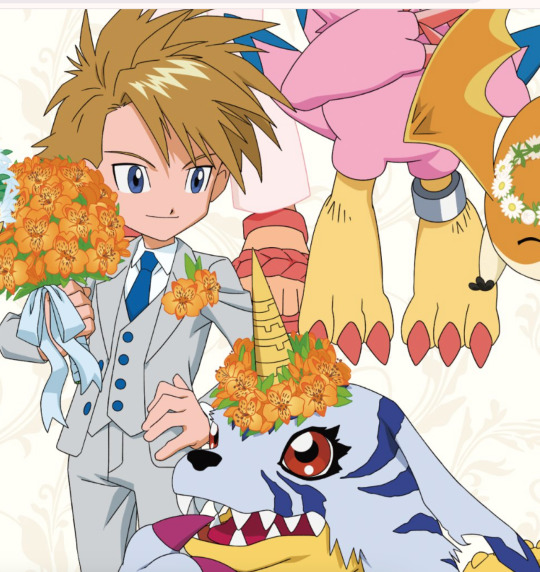
Yamato and Gabumon are seen holding Alstroemeria (Lily of the Incas, Peruvian Lily), and while the flower motif is not drawn onto his clothes, Yamato's coat's breast pocket is decorated with the flower as well. In Hanakotoba, Alstroemeria is meant to symbolise 'persistence/持続' or 'longing for the future/未来への憧れ', while in Western Language of Flowers it's meant to symbolise 'friendship' and 'devotion'. All meanings are apt for him imo, but especially persistence and longing for the future are very representative of his arc from the first series till Kizuna.
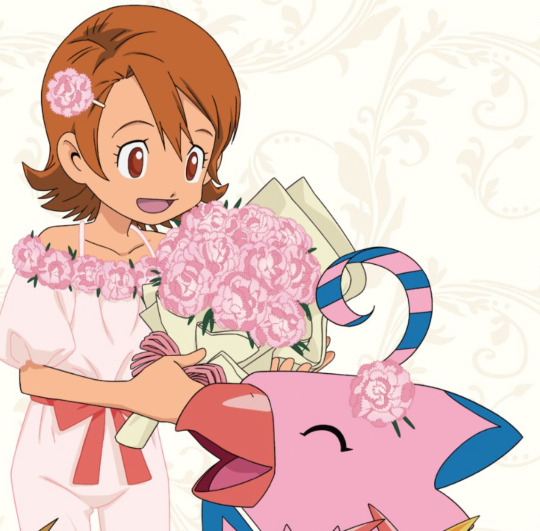
Sora and Piyomon are seen with Pink Carnations, with the neckline of Sora's jumpsuit lined with a bunch of the flowers. I personally love the visual of Sora in this pink jumpsuit, it plays into her slightly tomboyish yet extremely gentle personality so well! In Hanakotoba carnations symbolise 'innocent and deep love/無垢で深い愛' and pink carnations specifically symbolise 'love of a woman/女性の' 'passionate love/熱愛' and "beautiful gesture/美しいしぐさ'. In Western Language of Flowers carnations symbolise 'fascination' and love'. All meanings are pretty accurate for Sora, but red carnations are used to symbolise Mother's love in Japan so it would've been nice if they threw in a mix of red and pink to hint at her relationship with her mother!

Koushiro and Tentomon are seen holding Violet Sage, which at first glance I thought was Lavender. The flower pattern is also visible on his waistcoat and bowtie, which ties together his outfit very nicely! In Hanakotoba, Sage seems to have many symbolisations, 'respect/尊敬', 'wisdom/知恵', 'good home/良い家庭', and 'family love/家族愛'. But Blue (Violet) Sage specifically signify respect and wisdom. In Western Language of Flowers, Sage symbolises 'esteem', 'wisdom' and 'domestic virtue'. Again, a perfect choice for Koushiro, I personally would prefer to believe that they picked this not because of his crest but because of 'good home' and 'family love' since that part of Koushiro's arc in the first series was probably the most impressionable aspect of his character.
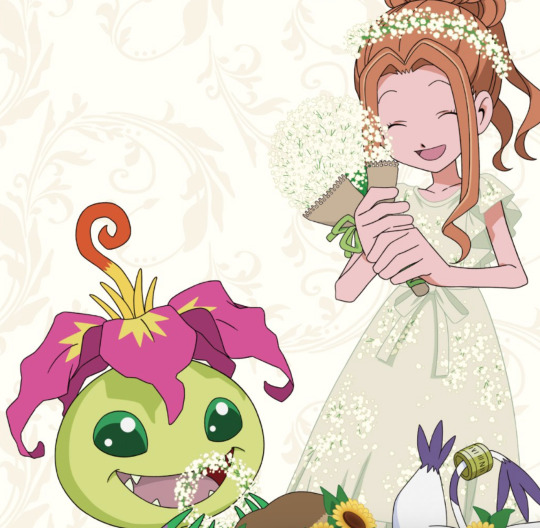
Mimi and Palmon are seen holding baby's breath, with Mimi's dress covered in a pattern of it. Even keeping my bias towards Mimi aside, this is possibly one of the prettiest outfit of hers till date, it genuinely looks like she's about to walk down the aisle as a flower girl for a very happy couple! In Hanakotoba, Baby's Breath or Kasumisou, symbolises 'pure heart/清らかな心', 'innocence/無邪気', 'kindness/親切', and 'happiness/幸福'. In Western Language of Flowers it symbolises 'everlasting love', 'purity of heart', and 'innocence'. All meanings apply to Mimi to the T, but they're also very apt for the whole wedding theme of the merch which makes this particular outfit + flower choice my favourite from the lot.
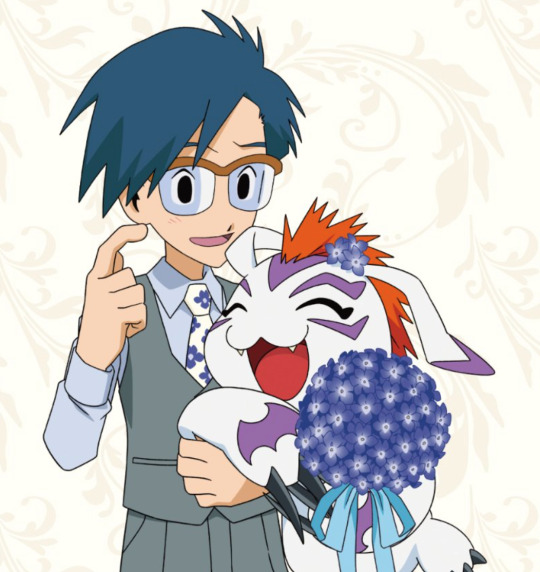
Jou and Gomamon are seen holding Violets or Sumire. I honestly struggled to figure out the flower for a while, at first glance I thought it was Periwinkle but since that was not mentioned in the Hanakotoba reference anywhere, I searched other people's interpretations and settled with Violets. His tie also has a cute pattern of the flower, and it makes me wonder if Koushiro and Jou went shopping for their outfits together! In Hanakotoba, Sumire symbolise 'modesty/謙虚', 'sincerity/誠実', and 'small happiness/小さな幸せ'. Depending on the colour, the symbolism can change in Hanakotoba, and purple Violets specifically represent 'fidelity' along with 'love'. In Western Language of Flowers it symbolises 'modesty' and 'faithfulness'. This is as Jou as a flower can get lol.
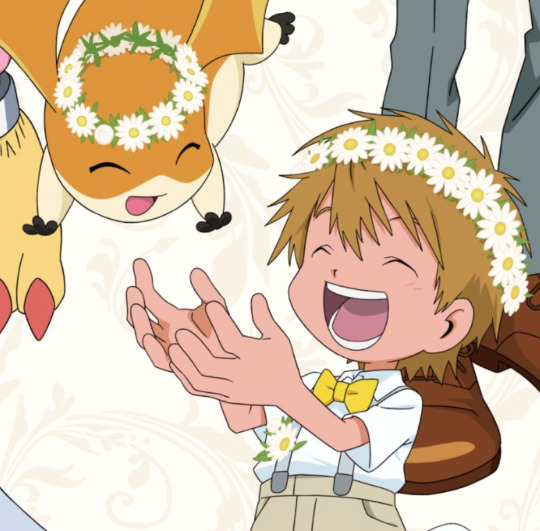
Takeru and Patamon are seen with White Gerberas. Like Yamato, Takeru's outfit doesn't have a pattern of the flower, but the Gerberas themselves are pinned to his suspenders. In Hanakotoba, Gerbera symbolises 'hope/希望' and 'always moving forward/常に前進'. White Gerbera specifically are used to symbolise 'hope' and 'honesty/律儀'. In Western Language of Flowers it is meant to symbolise 'cheerfulness' and 'beauty'. All meanings are accurate for Takeru, no comment needed!

Hikari and Tailmon are seen with Sunflowers. I personally feel that Hikari's outfit is a little too much compared to the rest, just the sunflower belt would've been enough but they added that extra line at the hem and it's kind of an overdose. In Hanakotoba, Sunflowers symbolise 'I gaze only at you/私はあなただけを見つめる', 'adoration/愛慕', and 'worship/崇拝'. In Western Language of Flowers, it symbolises 'adoration' and 'false riches'. I understand that they wanted to go with a bright or perky flower for Hikari but something like a Pink Aster which symbolises patience or Cosmos which symbolises harmony, peace etc. might suit Hikari better given the overall theme of the illustration. The only miss in the otherwise perfectly depicted theme and art!
#digimon#digimon adventure#taichi yagami#yamato ishida#sora takenouchi#mimi tachikawa#koushiro izumi#jou kido#takeru takaishi#hikari yagami#agumon#gabumon#piyomon#palmon#gomamon#tentomon#patamon#tailmon#digimon merch news#digimon commentary#ayushitposting
181 notes
·
View notes
Text
The flower that represents Ryuichi Naruhodo (Phoenix Wright)
Hello
I came to you with a tiny post
(I'm not lost and I'm not going anywhere.)
Because we missed an important detail again!
My favorite case is 3-1. In which there is just a huge pile of information.
When Chihiro interrogates a witness about the reason for her interest in Naruhodo, she gives an answer in the form of a haiku (although it is difficult to assess its correctness).


・・・・はかなげな、日かげに咲いた タンポポのような、たたずまい・・・・
hakana ge-na, bikageni saita tanpopo no yōna, tatazumai
... An ephemeral dandelion blooming in the shade...
リュウちゃんの、そんなところに ヨロめいてしまったのですわ。
ryuu-chan no, son'na tokoro ni yoro meite shimatta nodesu wa.
That's what Ryu-chan is like, and that's what made me fall for him.
儚い (はかない)
hakanai
• fleeting; transient; short-lived; momentary; ephemeral; fickle; vain
儚い or 儚げな can be used positively to describe some type of beauty found within weak/unstable/delicate things or people. It may be similar to so-called wabi-sabi.
げな (ge-na) - express the guess (it seems)
Madame literally calls Naruhodo "an ephemeral dandelion"
And gives a lot of food for thought, as it can be interpreted in many ways. After all, it is not just a randomly chosen flower.
The first thing that comes to mind is hanakotoba
In Hanakotoba (花言葉) Dandelions mean:
神託 (Oracle)
別離 (Separation)
幸福 (Happiness)
真心の愛 (Sincere Love)
愛の神託 (Oracle of Love)
Dandelions are known to be a fortune-telling flower which is why words like “神託 (Oracle)” are associated with it.
No less important meaning: dandelion is a symbol of courage, strength. Because this plant is able to grow in any conditions, and breaking through the asphalt, reaching for the sun.
Dandelion flowers also carry a meaning of wishing an ill person well, or happiness in times of darkness.
Suits our boy, doesn't it?
He represents each meaning: he was separated from his friend, he loved sincerely, he had a cold during the court hearing, and he found the strength to move on, making his own way when he was in unbearable pain.
We've dealt with the dandelion, now let's return to the "ephemeral".
On the one hand, everything is simple - dandelions look unreliable, weak, especially during the period of seed ripening. They are easily blown away by a weak breeze. Beauty and attractiveness that not everyone will appreciate. Why not ephemeral.
However, there may be much more meaning here. After all, another meaning is: short-lived
And then the phrase as a whole takes on a frightening meaning. She's literally says: he (the dandelion) will not be in this courtroom (in the darkness) for long. She literally predicts a "guilty" verdict for him, especially given her subsequent words. This is what she feels, what she wishes for him - to disappear into the darkness.
But her plans are not destined to come true, because the dandelion grows even through the asphalt.
___________________________________________
Well, and for comparison.


Mushrooms are often associated with spiritual growth, enlightenment, and rebirth. The mushroom's life cycle, with its ability to emerge from darkness and decay, represents the cyclical nature of life, death, and transformation.
This is probably a reference to Phoenix's name. Probably. That's all.
What do you think?
#ace attorney#gyakuten saiban#phoenix wright#naruhodo ryuichi#i said what i said#and yes i will use japanese names because i want to and i played the game with them. no complaining.#dahlia hawthorne#chinami miyanagi#in the GKS universe together with croq
45 notes
·
View notes
Text
youtube
This opening is replete with symbolism.
Flower language has been a recent fascination of mine.
Do you want to make my new hyperfixation your problem? If so, then let's take a deep dive into the first opening before the new one airs tomorrow.
Before I start, here are a couple of things to keep in mind.
While the use of flower language in this show mostly lines up with Japanese hanakotoba, there are still a number of flowers here that hold particular significance within Chinese culture, and thus have additional meanings that don't line up with those from Japan. I’ll be mentioning them alongside the Japanese meanings where I deem it relevant.
The following will contain light spoilers of content from the novels/manga which has not been animated at the time of writing. I'll try to be vague and sparing with it, but there are a few flowers I can't discuss without them.
Past the title card, the opening begins with eight blooming flowers dancing through the frame in rapid succession. These represent the storylines covered by the first cour of the anime in order of appearance, and each can be found in the episode(s) they signify. From the top:
Rhododendron: This plant is all over the first two episodes, so I'm going to cover its appearances before delving into its meaning. In episode one, there are two shots of the buds of this plant, one as Lihua gives birth, and then again as the doctor examines her baby. They're finally shown in full bloom as one of her ladies disregards the branch Maomao used to warn of the toxic makeup. In the following episode, Gyokuyou has seemingly taken a liking to the flower that saved her daughter's life, and a few clusters can be seen in a vase during several shots before Maomao uses them as an example of a seemingly innocuous plant that could cause accidental poisoning, and indeed, if you look closely at the background during the scene with the soldiers, you can see what appear to be rhododendron shrubs. There are actually quite a few different possible meanings for the many granular varieties of Rhododendrons/azaleas. Luckily, the characters said the name of the plant out loud for me: shakunage. So, this is Rhododendron subg. Hymenanthes. In hanakotoba it means dignity and majesty, but also, on account of its poison, danger and caution. Those last two meanings clearly line up with its ominous usage in these first episodes, growing and maturing as the babies grew sicker. But in addition to their function as a warning of danger, I think there's a case to be made that they also represent Gyokuyou herself. As I stated earlier, she starts keeping them after the first episode, and Hongniang later starts growing the closely-related azaleas in the jade pavilion as well. As for how its meanings apply to her, Gyokuyou is regal, magnanimous, and never loses her composure (unless it's at Jinshi's expense lol,) but she's also described by Gaoshun as shrewd and cautious, being unwilling to hire any lady she doesn't absolutely trust, and constantly gleaning information to send back to her family. These all fit with the dual meanings of rhododendron. In Chinese culture, rhododendrons and azaleas represent womanhood and passion, as well as home and a desire for homecoming.
Cotton rose: A type of hibiscus, this represents Fuyou, decorating both her person and her chambers in episode 3. It means 'delicate beauty' and 'graceful lover.' I think these are referring to both her skill in dancing, as well as her affectation of frailty and neuroticism. As far as I could dig up, its unique tendency to change color based on the time of day doesn't have particular bearing on its meaning in either Chinese or Japanese culture, but the story itself uses it as a metaphor for Fuyou hiding her passion, will, and cunning behind a wallflower exterior.
Balloon flower: In hanakotoba, it represents undying love, sincerity, and grace. These grow in the crystal pavilion, adorn the iconography of Lihua's furniture, and likely inform her blue and violet color scheme. Its last two descriptors gesture towards Lihua's style and personality. She's elegant and staid, but she also takes everything quite seriously, and wears her heart on her sleeve. As for the undying love element, I see that as alluding to her love for her son, her agony at his passing, and her hopes of reclaiming that love again through having another child.
Violet: This one actually tripped me up for the longest time. The flowers in the opening looked like hostas to me, but no matter how closely I looked at the backgrounds in this show, I couldn’t find anything along those lines. Eventually though, I caught on that these must be the violets from episode five, even if they’re a different color from those shown in the episode. And also droopier. Anyway, violets mean humility, sincerity, and ‘a little bit of happiness.’ In the episode proper, they are crushed underfoot as Maomao narrates about the lengths she had to go to keep herself safe while growing up in the red-light district, illustrating how even the modest aspirations of an ordinary peasant are in perpetual danger in such a cutthroat environment.
Chinese aster: Daisies and asters are my least favorite flowers to identify. They all look the same. As such, I’m a little less confident about this one, but I think it’s a Chinese aster. The leaves and buds look similar, and the context in which it appears in episode six suits its meaning. As Lishu’s ladies disparage her so-called pickiness, a shot of this flower opens the episode. While the Chinese aster’s meaning changes based on color, white in particular means ‘please believe me.’ I think that speaks for itself
Toad lily: This appears twice during episode eight, where Maomao gets drawn into the mystery of an attempted murder during her vacation. Toad lilies symbolize hidden thoughts and intentions, alluding both to the possible conspiracy on the part of the women of the brothel, and to the fact that Maomao will never really know the truth of the incident, having to content herself with speculation.
Sacred bamboo: This one is easy to miss, because while the plant is in full bloom in the opening, it’s laden with berries in the show proper. This is Nandina, a.k.a. the sacred bamboo, a mainstay of autumn and winter floral arrangements in both China and Japan. It’s considered auspicious, symbolizing a reversal of ill fortune into prosperity--the precise opposite of how it’s presented in episode nine of the show. There, Maomao fiddles with the plant as she contemplates all the instances she’s seen of good fortune being struck down by tragedy, and the prospect of that same sword of Damocles falling upon her head as well, a harbinger of eucatasrophe being used to symbolize straight catastrophe. Also worth noting is the fact that the plant is very poisonous, so much so that it has a reputation for killing any birds which try to eat its berries; I think that bit of trivia might be the inspiration behind the decision to ironically invert its lucky image. In addition to its central appearance in episode nine, it can also be seen in Lishu’s chambers in episode ten, mixed in among the vases of white camellias.
Japanese azalea: These mean passion and steadfastness, alluding, in my view, to Fengming’s devotion towards Ah-duo. Fun fact: did you know that honey made from toxic azaleas, termed ‘mad honey,’ is sometimes manufactured on purpose? It’s not super legal in most of the world, but apparently it can be used as a psychedelic.
After this, we see a panning shot of seven flowers, with the top four representing the high-ranking concubines, and the bottom three representing the high-ranking courtesans. While the first set of flowers grew from buds and flew across the screen, this set consists of still images. If I were to hazard a guess as to why, I'd say that it's because those previous flowers were conveying the movement of emergent stories, while these upcoming flowers portray the relatively static personality traits of individual characters. I'm going to tackle these in reverse order, as the first three flowers to appear are somewhat tricky to talk about.
Peony: This flower represents Gyokuyou, and in addition to appearing in her non-diegetic floral backgrounds, it also decorates the tapestries of the jade pavilion. In Chinese culture, peonies are one of, if not the most, important flowers. They represent feminine beauty, pride, honor, renown, wealth, prosperity, high-status, opulence, and a nobility of spirit. They are considered to be the king of flowers, and were historically only permitted to be grown by nobility. All of these superlatives are likely alluding towards Gyokuyou's status as the emperor's favorite consort, with the best shot at becoming empress.
Balloon flower: See above.
Lily-of-the-valley: This means purity, chastity, humility, and 'happiness will come again.' While the first three all seem to fit Lishu on their face, I find myself curious about the fourth meaning. I'm only partway through the third novel, but if this indicates that, at some point in the future, Lishu finally catches a break, then I'll certainly be happy to see it.
Dendrobium: In China, orchids in general are associated with elegance, refinement, and good taste, which fits with Maomao's description of the garnet pavilion as being beautiful in a minimalist sort of way. They also represent the virtues of an ideal gentleman-scholar: integrity, humility, temperance, and nobility. Furthermore, they are considered emblematic of spring; it, along with bamboo, chrysanthemum, and plum blossom, represent the four seasons. Returning to Japanese symbolism, the flower associated with Ah-duo seems to specifically be Dendrobium nobile. Nobile in particular means 'honest and to-the-point' in hanakotoba, likely alluding to Ah-duo's candid personality, and the fact that she is on casual terms with the emperor.
Regarding the final three flowers, the show itself doesn't explicitly tie any one of them to a particular courtesan--their flowers only appear as a group in episode twelve. But, by contemplating their meanings, and with some help from the characters' wiki pages, we can make some educated guesses.
Yulan Magnolia: This one, I'm guessing, represents Joka. On one hand, I'm kind of dumping her with this because the other two flowers just seem to fit the other two courtesans better, but its attributes nonetheless seem to accord what we know of her character--which admittedly isn't very much. In hanakotoba the yulan magnolia means nobility, sublimity and a love of nature. In China, its pretty similar: purity, nobility, dignity. It's also worth noting that they're commonly planted around Buddhist temples in China, and have been for many centuries, granting them an air of spiritual profundity. Joka is said to be aloof and cold, which is part of her appeal as a courtesan. While chrysanthemums and plum blossoms have a warmer aspect to their meanings, the loftiness of magnolia hews more closely to her characterization. Then there's the matter of her name, which is apparently a stage name. It translates to 'Lady Ka' (or 'Hua,' if you want to go with the Mandarin pronunciation.) Now, the 'ka' in her name is written as 華, and in the story, that character is only permitted to be used by the emperor and his family. So, for her to use it, even as a stage name, is a pretty bold pretense to nobility.
Chrysanthemum: In Japan, chrysanthemums are associated with nobility and the imperial family. In China, they are associated with longevity, endurance, and vitality, on account of their long-lasting blooms that persist late into autumn. I think this is most likely to be Pairin's flower. She's one of the few courtesans who's in her line of work because she wants to be, and is flourishing in an environment where others are desperate and debt-ridden. That covers 'vitality,' and Lihaku can attest to her endurance, if you know what I mean... Moving on, its mentioned in the novels that she's actually in her thirties, but still looks quite young, again harkening to the chrysanthemum's persistence.
As far as symbolism is concerned, chrysanthemums do seem to fit her character better than magnolias. But, something that gives me pause is her name, which means 'white bell,' on account of yulan magnolias being white and having a bell-like shape. I still think it's most likely that the chrysanthemum, and not the magnolia, belongs to her, but it was too notable a coincidence to not at least mention.
Plum Blossom: We can safely assume this one refers to Meimei, as her name is written with the character for plum. As plum trees are among the earliest to bloom each year, and will even bloom while snow still covers their branches, both China and Japan associate them with resilience, hope, inner-strength, and renewal. We don't know much about Meimei either, but my impression of her is that she seems to be the nicest and most even-keeled of Maomao's sisters.
Following this parade of showy flowers, we finally glimpse the emblem of our protagonist, Oxalis corniculata, the creeping wood sorrel, downcast and huddled amidst the underbrush of a forest. Whereas the other flowers we've seen thus far are primarily ornamental (even if some are also edible/medicinal,) wood sorrel is herbaceous and weedy, and is unlikely to grace any vases, wreaths, or arrangements. If it were spotted in a noble's garden, it would likely be uprooted, but to the peasant who finds it growing in a ditch, it's a tasty snack.
In hanakotoba, wood sorrel means joy, 'shining heart,' and 'a mother's love.' All three descriptors, I believe, are relevant to Maomao's character. Despite her flat affect, Maomao has a strong passion and sense of joie de vivre driving her through life. Those further along in either the novels or the manga will recognize 'a mother's love' as (somewhat ironically) gesturing towards her complicated relationship with her mother. As for 'shining heart,' I think that will become apparent as we go further through the opening.
But, before we do that, I'd like to take a moment to examine the moments when wood sorrel appears in the show itself. Thus far, by my recollection, it has appeared in episodes one, three, and twelve. The opening shot of the first episode is of a wood sorrel, informing the viewer in no uncertain terms that this is Maomao's flower, (in case the opening was too subtle.) In the third episode, several wood sorrels dot the field where Fuyou sits with her lover, symbolizing how Maomao has aided and protected them. In episode twelve, a single wood sorrel is tucked inside a lavish bouquet of her sister's flowers, a visual gag paralleling them fussing and fawning over her.
Returning to the opening, Maomao is shown contemplating a subtle glow in her closed hands while a reflected, sunlit version of herself glances back at her. Then, as all the previous flowers fall away, as Maomao casts the light up into the air, its glow illuminating her face, the wood sorrel finally stands upright, and blooms in full.
Now is a good time to mention a relevant characteristic of creeping wood sorrel: it only blooms in direct sunlight. When crowded by other plants, it curls in on itself, closing both its flower and leaves. This serves as a clear metaphor for Maomao's personality; under most circumstances, she seeks to be invisible and unobtrusive, but when she's in her element, she commands attention and respect.
Following this, we have her magical girl-esque transformation sequence, with her outstretched hands forming the shape of a blooming flower as she dances through a whirl of yellow wood sorrel petals. She then bows down in imitation of the flower, taking the light back into her chest (there's that shining heart I mentioned earlier,) as she dissolves into the stoic, unassuming version of herself once more, closing out the opening. (Jinshi who?)
I'd like to end this analysis with an observation. While the real wood sorrel exists at the perpetual mercy of outside forces, Maomao is not merely reacting to a light source that exists beyond her control. The light exists within her, and she chooses when it will shine down for all to see, and when she will hide it away in the depths of her heart. To those who've gotten this far, thank you so much for reading.
#the apothecary diaries#i like being mean to a certain someone#but i will note that i'm familiar with the interpretation that the lyrics of the op are written from his perspective#and i would agree that that reading has merit
187 notes
·
View notes
Note
What do you think of itafushi and satosugu?
Ah I think I was asked about this before but back then my opinion was very non-opinion. Because I hadn't gotten that deep into the series yet. I also answered an ask about satosugu earlier.


I will say that they complement each other very well. They understand each other better than other characters, like I don't believe that something like Gojo not realising how bad Geto's state was until it was too late would happen with Yuuji and Megumi because they seem to figure each other out pretty well. Gege also did draw parallels between Geto-Gojo and Yuuji-Megumi duos. But that's not something I'm gonna focus on here.
(Manga spoilers up to chapter 266 ahead!)
Yuuji and Megumi's relationship is deeply intervowen into the text of the manga itself. The fact Megumi chose to save Yuuji despite the fact it put more people at risk is what sort of started everything. And the actions of the two impact each others development.


Todo was asking Megumi about his type, and when he is not hearing an answer he adds that it's fine if he prefers men. Why is this needed here? Gege is not making a joke, like a homophobic joke some average dudebro author would make because a male character is taking his time to answer, where said male character then gets offended and the audience laughs. Todo is very chill, it's a non-issue for him. Megumi is also not shown to be offended or even phased at the implication. Well there is no joke, so why did this need to be added? To imply. To hint. To put the idea in the reader's head. And then Megumi answers and uses 'person' instead of a girl/woman. Also the fact many male characters seem to point out Megumi's cuteness/attractiveness makes it even more obvious that Gege seems to like the idea of Megumi being 'available' to both men and women. Obviously women think he's cute as well but that's sort of given.
Megumi's type is someone who has an 'unshakeable character' according to a translator I asked about it. I once read another person say it's 'unwavering humanity'. This translator said this goes with Yuuji's name. Regardless, Yuji's name has 'unwavering/unshakeable benevolence/compassion/humanity' so whether the word refers to unshakeable humanity or character, both fit Yuji and the type clearly is a nod to his name. Which many translators have pointed out.

However when asked about his type, Megumi thought of Tsumiki.
Before that, when Yuuji "died" Megumi was imagining Tsumiki on a field surrounded by countless sunflowers. Now we know Gege is aware of hanakotoba, since he mentioned the meanings of both white lilies and black lilies in the manga, and he drew them around Tsumiki, to reference her innocence/purity (white lily) and the fact she was cursed (black lily). Sunflowers apparently symbolise passionate love, and the more sunflowers, the more intense the love is. 11 sunflowers is true love, 108 sunflowers is marry me etc. So there is that implication that Megumi's feelings for Tsumiki might be not completely familiar... Megumi is someone with abandonment issues, because his mom died and his dad left. So he has low self esteem and doesn't value his life. But he had Tsumiki. And he developed that intense need to protect her and care for her. In Jujutsu Sousen which is the prototype for jjk, Yuuji also mistook Tsumiki for Megumi's girlfriend, and Megumi's reply was that "well, she is someone important to me". Megumi did everything for her happiness' sake, which is why he lost all hope and will when she died.
Gege also drew Yorozu and Sukuna in their bodies, with Yorozu acting the way she did towards Sukuna and talking about 'love' as a sort of dark humour.

Yet, I do see that Megumi has a soft spot for Yuuji.



Megumi tries to come up with ways for Yuuji to live, while Yuuji tries to come up with ways to die. I noticed Megumi is a bit tsundere because he's not that smooth about comforting another person, so he comes off a bit mad like here, calling Yuuji selfish for caring about him, haha. Which is kind of call back for Megumi saying his decision to save Yuuji was a selfish decision?
Back to Tsumiki.

It feels like in the absence of Tsumiki, Megumi started to look for Yuuji as someone to idealize, as someone who to learn from. That mission where he took the criminal's badge to give to his mom, that action is something he wouldn't have done without Yuuji's influence. And in this moment above he's thinking about both of their genuine, sweet smiles, placing them next to each other in his mind. Yuuji has in a short time become someone important to him. But it's very telling how his type of people in his mind are Tsumiki and Yuuji. It's not even subtle from Gege.



And as I said it seems like Megumi has a bit of a soft spot for Yuuji.



Which is why Yuuji has this effect on Megumi. I never see Megumi melt like this as a response to other people. It's like Yuuji gets through his defenses.

Here's the tsundere again. Megumi shows his care with certain level of aggression because like I said, he's not the smoothest person around.

Even when he's about to die, he thinks about Yuuji. I do think it makes sense that someone like Yuuji has become so important to him in such a short time. Because he's Megumi's type of person.
And I also noticed that whenever Megumi smiles in the manga, it's either due to him making progress as a sorcerer or it's because of something related to Yuuji.



It's the framing here how Gege does the little smile that I find interesting.
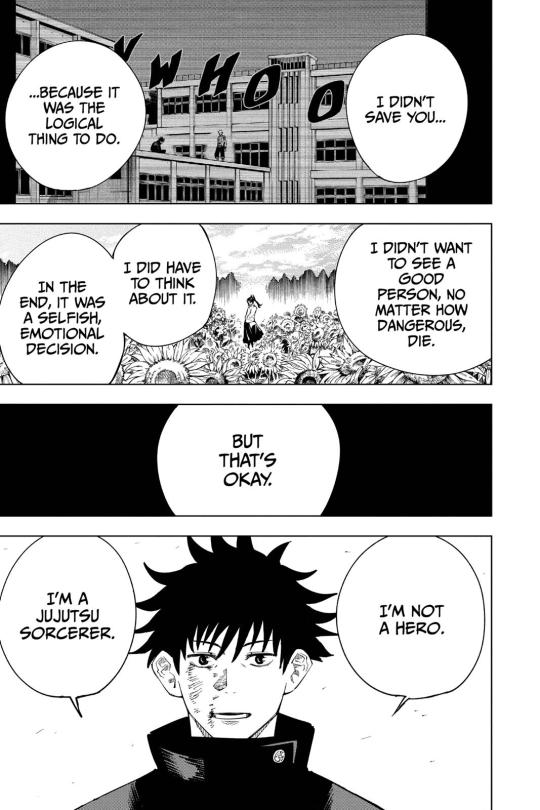
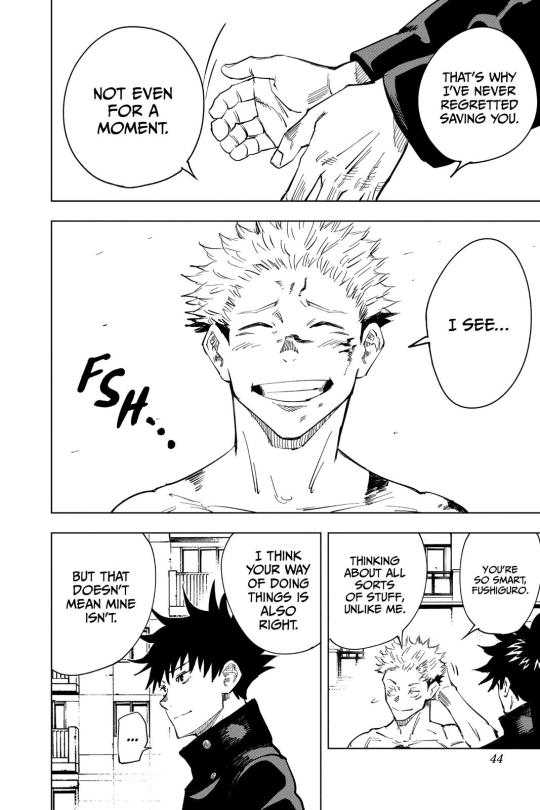
Of course there's also this moment where we see a very genuine Megumi smiling. This moment is very important because it was even used in the recent MV with Yuuji, Megumi and Sukuna. I think Megumi's connection to both is very important to the conclusion of the story.
Notice how I talked mostly about Megumi? Because the differences in his behaviour are easier to notice, compared to Yuuji's "I get along with everyone" personality. Obviously, Yuuji does like Megumi a lot, as we see in the previous images he easily gives him compliments like calling him reliable and smart (or even cute when teasing him with Hana lol) and he is also very protective of Megumi.



What's funny is that the last moment immediately reminded me of Naruto and Sasuke's dynamic in the land of waves. It's identical (please don't kill me narusasus who dislike itafushi and itafushis who dislike narusasu). I also think he really does admire Megumi and immediately notices him first out of all the other people (like with Ozawa and Nobara). And just like Yuuji influences Megumi, Megumi influences Yuuji, and makes him think outside of his own mindset "what if someone you saved killed someone else in the future?". They both also acknowledge each others differences and respect them.
I don't think his answer to Todo (I mean he seemed unsure in his answer too) or his comment about Jennifer Lawrence are necessarily dealbreakers considering this is Gege lol. Gege seems to make Yuuji indecisive, like how he couldn't answer the question whether he prefers dogs or cats because he's unsure, or how he says "I guess" when referring to his type of girl. He says 'tall girl' but when actually tall girls that fit his supposed type show up like Ozawa and Yuki, he doesn't show that kind of interest in them. I'm not saying he can't like girls by the way, I'm just saying Gege hasn't shown Yuuji show genuine interest in women unlike for example Horikoshi has with Deku. With Yuji it's a one-note joke, with Deku we actually see him show attraction.
But the reason why I point these things out is because Gege is very particular about Megumi's character, to the point his editor commented on it, so I don't think he would draw things for no reason. If Yuuji is the only person that makes the usually stoic Megumi smile and if he manages to melt down Megumi's worried/distressed side then that is something important, since Gege feels the need to repeat these situations. Author intent is always important. However I know some people probably aren't fans of this but Gege is clearly very fixated on the connection between Megumi and Sukuna as well. Possibly even more so. They have a lot of connections that would need their own post. I talked a bit about Megumi and Sukuna here but it's not even close to being everything you could write about Gege's writing concerning them. Also, Yuuji and Sukuna can't stand each other and are currently pretty much fighting over Megumi (lol). I don't think Megumi will stay passive though, as we see in this recent chapter, he is fighting back. But it's something to think about.

And in this recent chapter, Megumi is once again placing Yuuji and Tsumiki next to each other, imagining a calm, relaxed life with them. I already imagined that one of the character image songs Gege chose for Megumi , Weezer's 'Island in the Sun' was just about having fun with Yuuji and I was right!



Yuuji dares to finally admit he needs Megumi too. And Megumi's comment 'Someone like you'... Megumi really does place Yuuji high, and I think people are starting to see it. Yuuji makes him happier and more relaxed. And the fact he lost all will to live, yet regained it because Yuuji would be lonely without him, speaks volumes as well. And to Yuuji Megumi is also a special person. I don't know if there will be a happy ending for them, but they definitely changed each others lives.
43 notes
·
View notes
Text
Floriography: Resources for Writers
For centuries, flowers, herbs, and other plants have been used to convey meaning, both in life and in literature. Many of the greats, including Shakespeare, Austen, the Brontë sisters, and Steinbeck referred to floral symbolism to delicately weave into their intricate works. Flowers influenced art for generations before us, and with luck, they will continue to inspire artists for generations after us--long after we've become them.
Victorian Floral Code.pdf
Floriography: An Illustrated Guide to the Victorian Flower Language by Jessica Roux
Language of Flowers Wiki
Hanakotoba - Japanese Flower Language Wiki
Ikebana - Japanese Flower Arrangement Wiki
Kate Greenaway's Language of Flowers
Floral Emblem Guide
Plant Motifs In English, Russian, and Tatar (pdf)
Flower Language Myths
Language of Flowers.com
#culture#language#writers#author#writing reference#reference#victorian flower language#poets on tumblr#japanese folklore#slavic folklore#motifs#creative writing#indie author#floriography#for future reference#resources#writing tips#writing advice#writing tools
232 notes
·
View notes
Text
Sooo I'm sure this could've been talked about before but I wanted to analyse the flowers that appear in mika's demon world

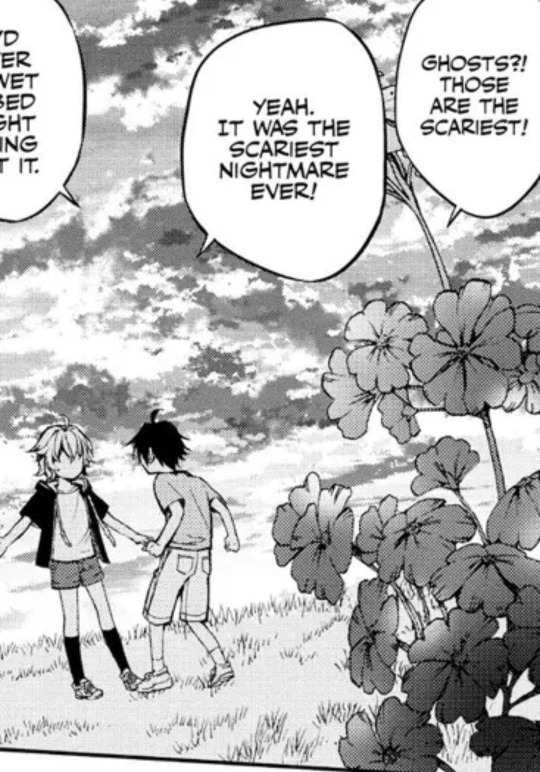
Now they are only present in two panels, but both times they're in the foreground— which could either mean they're intentionally framed to be an object of focus, or just an artistic decision for composition depth.
For the plant itself, it's pretty obvious to me as a type of candelabra primula based on the tall stems and layered appearance. Which makes sense, they are native to parts of China and Japan, specifically damp environments
The thing is, I'm not sure if they're going for a specific kind of primrose, but if I were to narrow it down, I believe the Japanese Primrose holds the most resemblance. Specifically primula japonica, not primula sieboldii. Even though they share the same common name, sieboldii does not grow in the same tier-like way


^^^primula japonica for reference
Unfortunately, trying to find meaning for this specific flower is difficult. Because of how the common name is shared with the sieboldii, information gets confusing. The Japanese name for the sieboldii is Sakurasou, and the Japanese name for the japonica is Kurinsou, which helps with the distinction. However, it also makes it much more apparent how little info there is on the Kurinsou!! Kinda frustrating, but I am determined to find the meaning to these flowers..
Thanks to a little help from the hanakotoba (japanese language for flowers) and from various other cultural interpretations, the general primrose primarily symbolizes both youth (specifically young, sacrificial love) and new beginnings (renewal & optimism).
Now, I want to point out something. This is the entry in the hanakotoba for a generic primrose:

"I can't live without you" oh wow okay man. Surely this has no relation to mika's character


I also found this reference cool in relation to demon mika

"'the primrose path' implies the thoughtless pursuit of pleasure,"

Additionally, due to its Latin name "primula" coming from the word "primus" it has associations with the word "first"— indicative that they're one of the first to bloom in early spring. Other but not as prominent meanings for primroses include resilience, femininity, and the transient nature of life (birth & death.)
Anyway, it doesn't really add anything to the story, more than likely just reinforces already laid-out points of his character, but I thought it was fun to seek out nonetheless! Thanks for reading, and I'd love to hear anyone else's interpretations/additions since i've never done this before and I could be very wrong about things haha ^^;
#owari no seraph#seraph of the end#ons#mikaela hyakuya#sote#owari no serafu#owari no seraph analysis#ons analysis
21 notes
·
View notes
Text
This took a week but here it is vessel wears a kimono specifically for spring-autumn season :D!

It looks plain at first but you’ll see tentacles on the shoulders if the lightings juuust right
Watch as I ramble (too long abt the design) here’s another version without the Haori !

5 days from a family trip suddenly falling ill for ii days as I’m writing this, wanted to give up after thinking “man it kinda looks ass now” or looking at it too long but I’m too stubborn for my own good lol
Randomly remembered a YouTuber Im following already has a vid abt male kimonos so this is where the inspo started !
I use red, black, blue, yellow(gold) undertones trying my best to make it as close to the color palette of the band aesthetic as possible also I associate blue with Ves a lot haha, the spine probs came from the tomb brainrot, you can’t see it but the end of the sleeves has waves representing the track visuals, and cylcamen attached as a reference from @/chrishardy.design 's post from ig months ago after looking up the meaning both floral language& Hanakotoba , I gotta include it in someway…
The Haori-himo ( the string attached) has 12 beads representing how each 3 albums has 12 tracks, like the 3 blue diamonds (also ascensionism reference for fun) jokingly it can represent his bandmates cuz they all got blue eyes idk, originally it’s supposed to have the runes spelling out “worship” but felt like I’m adding too much besides male kimonos have pretty simple designs and I’m trying my best not to go maxilism grind mode in every character design:p
Oh yeah if you’re wondering abt the scarf it’s here!
alright that’s all! it was fun but I’m finally done whew😭🗣
#sleep token#vessel#vessel sleep token#fan art#sleep token vessel#hackus art#realizing this is also the first time I’ve drawn vessel that isn’t a chibi or shit post or furry aka my usual style#doodle#my art#sleep token fanart#kimono#fuuucck I’m so out of energy this month#but we pull through chat
34 notes
·
View notes
Text
Bleach Hanakotoba Analysis Part 2 ~ ED31: Saihate
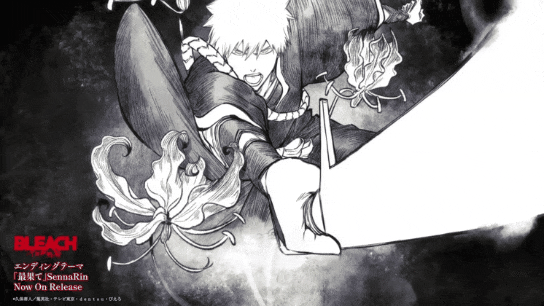
○●○●○●○●○●○●○●○●○●○●○●○●○●○
-> Rukia Kuchiki: Cherry Blossom


In the extended version of Bleach’s 31st ending theme song, Rukia Kuchiki is pictured with branches of the cherry blossom tree. The cherry blossom (Prunus serrulata) is also known as the Japanese cherry and is the unofficial national flower of Japan. Its Japanese name Sakura (桜) has been derived from the word “saku” which means “to bloom”. Its meanings in hanakotoba are “beauty of spirit”, grace, chastity, excellent beauty, gentleness, good education and the “transience of life”. In Japan, cherry blossoms are also a symbol of the “beauty of impermanence”—a Shinto concept better known as “mono no aware” (物の哀れ) as their falling petals are a reminder that although life is short, it is beautiful and should be savoured. The Japanese concept of “natsukashii” (懐かしい) likewise emphasizes the fleeting nature of cherry blossoms. This concept refers to the happy-yet-wistful nostalgia for times and things that we will never be able to go back to. We will never get to experience those moments again, just like the ephemeral cherry blossoms, which makes them even more significant. Cherry blossoms bloom from March to April which is the start of the new fiscal year in Japan. As a result of this cherry blossoms have also come to symbolise new beginnings and springtime. Given that feudal Japanese soldiers associated cherry blossoms with honour, discipline, and dignity—falling flowers were thought to be symbolic of a Samurai's death. In Western floriography, cherry blossoms herald the changing of the seasons and symbolise renewal and rebirth. They also symbolise the fleeting nature of life, tenderness, forgiveness, strength, beauty, love, confidence, peace, friendship and gratitude. Rukia Kuchiki presents herself as a cool, restrained and stern warrior with firm convictions, however occasionally she breaks out of her shell and is kind. She tends to keep her emotions to herself, unless she is irritated, and finds it difficult to confide in others. This ties in with the cherry blossom’s meanings of grace, discipline, chastity, honour and dignity. Throughout the series, Rukia is constantly improving herself and growing not only in strength but also in confidence. This complements the cherry blossom’s meanings of confidence, strength, new beginnings, springtime and the changing of the seasons. One of the cornerstones of Bleach's development is the connection between Ichigo and Rukia. Ichigo was able to protect his loved ones and become involved in the affairs of the soul society thanks to Rukia's initial transfer of her abilities to him. Since then, they have often come to each other's rescue and have developed a strong sense of gratitude, admiration, respect, and trust for one another. This ties into the cherry blossom’s meanings of strength, gratitude, friendship and love. Cherry Blossoms also tie into Rukia’s connection with her adopted brother, Byakuya and her sister, Hisana. Upon her death, as she looked at the first cherry blossoms of the season, Hisana asked Byakuya to find and protect Rukia as she regretted abandoning her years ago and felt unworthy of being her sister. This complements the cherry blossom’s meanings of forgiveness, love and the fleeting nature of life.
-> Uryū Ishida: Edelweiss
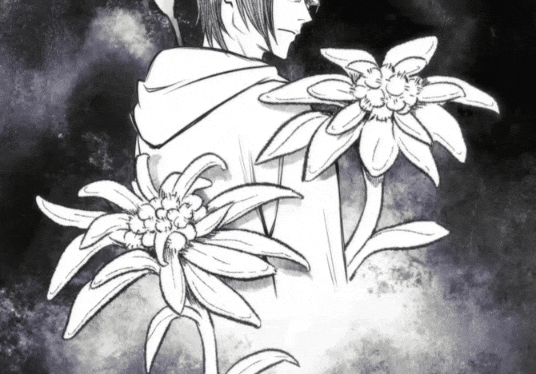
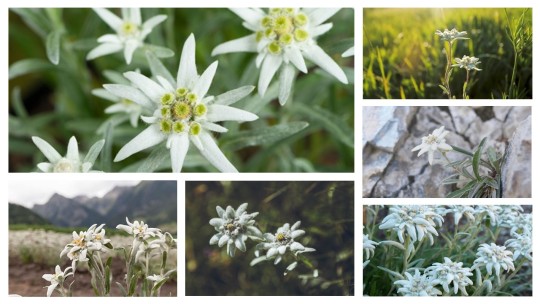
Edelweiss (Leontopodium nivale) is known as Ēderuwaisu (エーデルワイス) in Japanese. Its meanings in hanakotoba are are courage, power and precious memories. Its name translates from German to mean "noble white". Edelweiss is only found in white-blooming variants, unlike most other flowers. These reasons are the basis for the flower's symbolic connotations in Western floriography, which include innocence, purity, renewal and wishes for peace. The flower also represents integrity, excellence, elegance, noble courage, and boldness. Edelweiss flowers are well-adapted to high-altitude environments with frigid temperatures, harsh sunlight and low oxygen levels and have thus come to represent rugged beauty, strength, nobility, adventure and perseverance. The Edelweiss flower also represents intense devotion, sacrifice, care, and deep love. One of the most well-known stories about the edelweiss is about a young man who, in an act of bravery and love, risks his life to climb a mountain’s steep rocky face to gather edelweiss flowers for a woman. Uryū Ishida is typically reserved, independent, and solitary—however, he tries to act cool when among other people. He has a strong sense of justice and is incredibly intelligent and chivalrous. These attributes greatly complement the Edelweiss’ meanings of integrity, excellence, elegance, boldness and noble courage.
-> Renji Abarai: Sasanqua Camellia

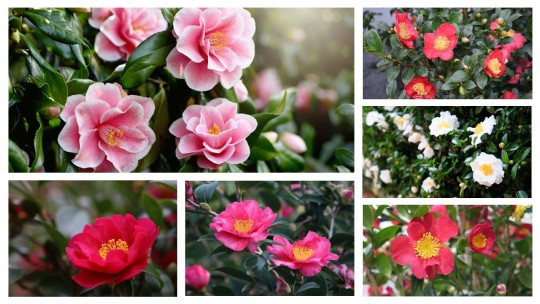
The flower Renji is pictured with is the sasanqua camellia (Camellia sasanqua) which is a species of camellia native to both China and Japan. It is a different species than the camellia pictured with Byakuya Kuchiki in this ending (Camellia Japonica). The Camellia Sasanqua and Camellia Japonica are primarily differentiated by the former’s earlier blooming season (early fall to early winter) as well as its smaller leaves and flowers. In addition to this, Camellia Japonica’s flowers fall whole, while Camellia Sasanqua's petals fall apart. The sasanqua camellia is known as the sazanka (山茶花) in Japan. Its meanings in hanakotoba are dedication and overcoming difficulties. In Japan, red sazanka represents humility and beauty, white sazanka represents charm and rejection and pink sazanka represents eternal love. In Western floriography, the sasanqua camellia represents desire and passion. It is said that the sasanqua's meanings of "overcoming difficulties" and "dedication" are derived from the fact that flowers bloom in early winter when the cold intensifies. Renji Abarai comes across as dynamic, eccentric, brash, and stubborn, yet he is also incredibly dedicated and determined, willing to fight and die for his convictions. This ties in with the sasanqua’s meanings of passion, dedication and overcoming difficulties.
-> Yasutora Sado: Canna Lily
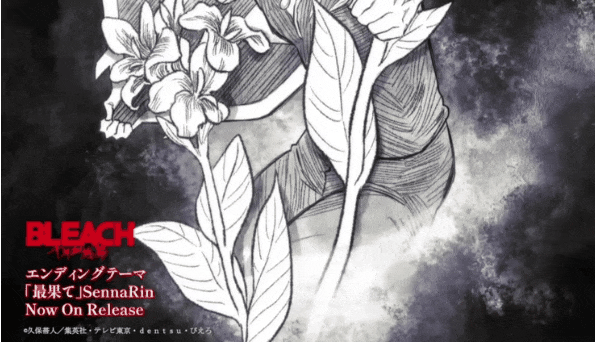

The Canna lily (Canna) is known as kanna (カ��ナ) in Japan. Its meanings in hanakotoba are passion, cheerfulness, eternity and delusion. In Western floriography, the canna lily holds the meanings of beauty, protection, purification glory, power, hope, confidence and confiding in heaven. The flower also holds the negative connotations of paranoia and suspicion. The vigour and beautiful appearance of its flowers, which can withstand the midsummer sun, are thought to be where its meanings of passion and cheerfulness are derived from. Yasutora Sado is a quiet but incredibly brave, strong, and kind person who is also extremely loyal. These traits tie in with the canna lily’s meanings of passion, power, confidence and protection. Additionally, canna lilies originate from Latin America and tropical Asia and are exotic and vibrant with a rich cultural and symbolic history. This ties in with Sado’s half-Mexican heritage. In mythology, it is said that a demon who was envious of Buddha’s strong spiritual power threw a large boulder down on him from above. However, most of the rock shattered at Buddha’s feet without hitting him with only one fragment hitting his toe. Where the blood from his wound dripped onto the ground, a red canna lily blossomed, and the devil was swallowed by a rift of the earth due to its wrath. This legend is reminiscent of the scene where Sado was struck by a falling steel beam, which fractured but did not injure him as well as one of his fullbring powers, named “Left Arm of the Devil”.
-> Orihime Inoue: Glory-of-the-snow


Glory-of-the-snow (Scilla section Chionodoxa) is known as yukigeyuri (雪解百合) in Japan which translates to “snowmelt lily”. Its meanings in hanakotoba are purity, innocence, hope, modesty and compassion for friendships. It is also considered a sign of spring as it blooms when the snow melts. In Western floriography, it symbolizes glory, camaraderie and toughness. Although she comes out as naive and ditzy, Orihime Inoue is better described as being sensitive, caring, amiable, funny, and optimistic. This strongly complements the glory-of-the-snow’s meanings of purity, innocence, hope and compassion for friendships. Furthermore, the star-shaped, six-petaled flowers of the glory-of-the-snow closely resemble Orihime's flower hairpins that her late older brother had given her.
○●○●○●○●○●○●○●○●○●○●○●○●○●○
[If you liked this post, check out part 1 (here) and part 3 (here)... Also, here's the link to my directory of other hanakotoba analysis posts (here)]
[P.S. Here is the continuation of my hanakotoba analysis on Bleach as promised... Thank you to @jushiro-ukitake & @elyonholic for reminding me about the flowers featured in the extended ending. Given that the flowers are black and white, it was difficult to identify them—so if I misidentified any of them, I apologize; I did my best. Also, I had to put the Gotei 13 squad flowers in a separate post because of Tumblr's image limit...]

#tried to keep this brief but ended up rambling lol#bleach#bleach anime#hanakotoba analysis#bleach hanakotoba#bleach florigraphy#hanakotoba#floriography#anime hanakotoba#anime analysis#bleach ed 31#bleach op16#anime openings#anime endings#anime music#anime#bleach tybw#bleach tybw part 1#bleach tybw part 2#bleach tybw anime#tybw#gotei 13#soul society#rukia kuchiki#kuchiki rukia#ichigo kurosaki#kurosaki ichigo#uryuu ishida#ishida uryuu#uryu ishida
78 notes
·
View notes
Text
【KagePro】 KuroEne Ticket Commission by Mire 🖤💙🐍🐇
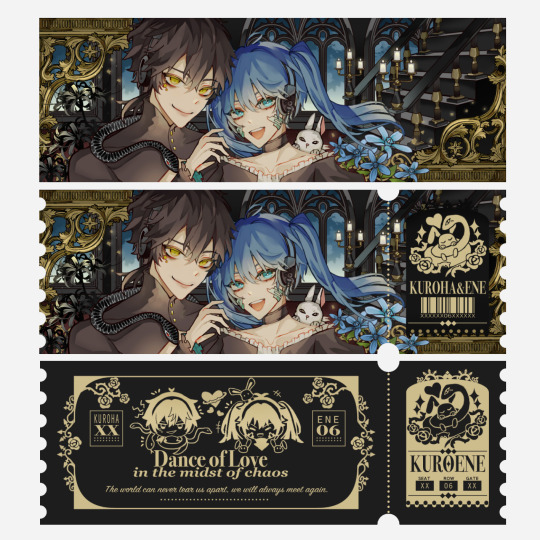
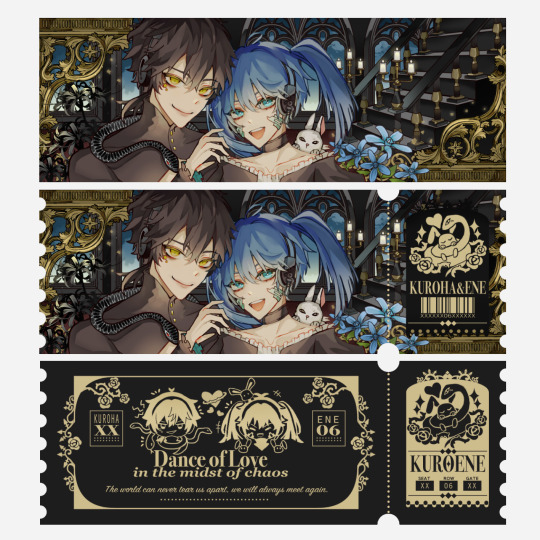
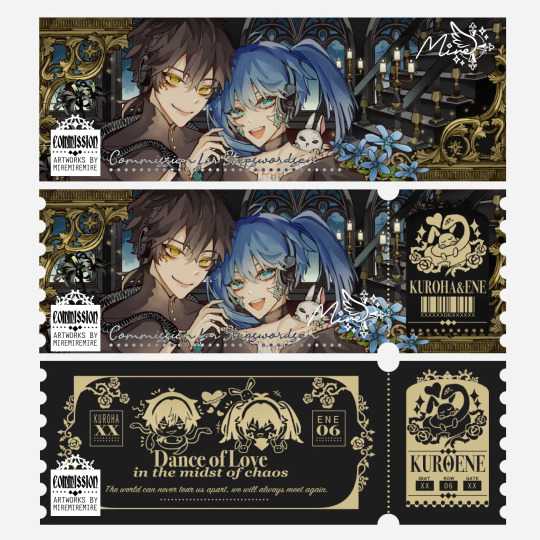
Kuroha (Saeru) and Ene Ticket Commission by Mire (@/miremiremire)
Mire's Instagram: (X)
Mire's VGen: (X)
Intro
Dance of Love in the Midst of Chaos (*)
"The world can never tear us apart, we will always meet again." (*)
"I'll let you taste the biting fangs of love, and the intoxicating poison of pleasure…"
"I'll take you even further… I'll push you to the brink, and let you fall with me into the abyss. Ene..."
"Now... Shall we dance again?"
I commissioned KuroEne wearing formal wear in a Gothic ballroom with a Snake and Bunny theme, while they're surrounded by their flowers: Black Higanbana (Cluster Amaryllis) and Blue Star Milkweeds (Tweedia) 🖤💙🐍🐇💐
I asked for Kuroha to be drawn in his Design Poll outfit, and for Ene to be drawn in her Seek at Mekakucity outfit 🥰
I asked for a Snake wrapping around a bunny with hearts, sparkles, and roses, and provided the ticket info, including the seat numbers and quotes.
Thank you to Feila for helping me discuss and come up with ideas 💗 Feila came up with the title (live concert name) and quote used in the commission, which I marked with an asterisk (*)
"Dance of Love in the Midst of Chaos" = Live Concert Name
"The world will never end, we will always meet again" = Quote
I'm glad you were able to share your thoughts with me!
I also thought of using quotes from my KuroEne AU for the commission, but they wouldn't fit, given the space, so I just decided to include them here.
Ene's Mekakushi Dan number code is 6, and Kuroha is known as XX/XXX since he's not apart of the Mekakushi Dan.
So I thought it'd be a neat reference to include in the Ticket info~ The seat/row/gate numbers are a genius combination.
I chose Black Higanbana and Blue Star Milkweeds as KuroEne's flowers based on their Hanakotoba meanings. The colours and flower symbolisms suit them very well. So I asked for them to be included in the comm.
Kuroha: Higanbana - The Flower of Death, Death and the Cycle of Rebirth
Ene: Blue Star Milkweeds - Happy love, hearts that believe in each other
Mire drew both a long and short hair version of Ene's hair! I love both versions, but I love how flowy her hair looks in the 1st one. I feel like it fits very well with the composition.
Mire included Kuroha's yellow circles on the Oshi mark of the snake wrapping around the bunny. Oh my god... I love the inclusion of the thorned roses as well... 🌹
The snakes wrapped around Saeru and the bunnies around Ene... Cute... 🥺
There's SO much detail and effort put into this...
Thoughts
I'm SUPER happy with how my commission turned out! 💗✨ Everything is so breathtakingly beautiful! Mire's art style, colours, rendering, and attention to detail are so amazing! I was awed by how detailed the background is~
My commission is SO stunning! I'm still in awe by the commission! KuroEne look SO pretty in Mire's style! 🥺😭💗💘💞
Mire perfectly captured the couple's themes and expressions 🥺💖 I love how the small chibis on the ticket came out too~
Mire first sent me a message a few days ago to check in with me asking if any revisions need to be made.
Mire was very accomodating with minor colour and detail fixes, such as with Kuroha and Ene's headphones, Kuroha's yellow circles, Ene's digital facial structures, and the snake on Kuroha (which I asked to change from a white snake to a black snake with red eyes)
The changes fit them a lot more so I'm very grateful!
Great communication and very quick with updates. I'll definitely be back to commission Mire again in the future! ✨
Mire seriously outdid my expectations tenfold...
How detailed the gothic ballroom is, the flowers (black higanbana and blue star milkweeds), the snake and rabbit around them, the ticket design with the little chibis, and icon of a snake curling around a bunny…
The ticket design is CRAZY good, along with the colours and rendering OMFG
I wasn't expecting the little chibis… They're such a nice touch
I was so surprised too because the turn around time was way faster than I expected... I sent the comm form around Oct 19
Feila pointed out that event tickets are usually printed on thermal paper, so I'd love to print out my commissions for personal use.
Misc Rambles
OH MY GOD MY HEART JUMPED WHEN I FIRST SAW THE ART
THE DETAIL IS CRAZYYYYY... THE CHIBIS ARE SO CUTE~ THE COLOURS AND RENDERING ARE SO GOOD AND THE FLOWERS AND BGS ARE SO WELL DRAWN!!! I'M OVER THE MOON!!!
I'M GETTING EMOTIONAL 🥹😭💗💘💞🫶✨
THEY LOOK SO GORGEOUS I'M ON THE FLOOR
HELLO I NEED TICKETS PLEASE
KUROENE INVITE ME TO YOUR WEDDING!!! 💥💥💥
ENE MY WIFE!!! MY PRINCESS!!! MY ANGEL!!! 💙💗💘💞✨
I LOVE HOW FLOWY HER HAIR LOOKS
MIRE MADE THEM LOOK SO GOOD THEY'RE SO PRETTY
THEIR EXPRESSIONS AND THE COLOURS AND RENDERING TOO!!!
THE ART IS SUCH VISUAL EYE CANDY...
ENE LOOKS LIKE SUCH A PRINCESS HERE... MY BEAUTIFUL PRINCESS
MY WIFE AND HER CRAZY ASS SNAKE BF
I'M OVER THE MOON ABOUT THIS 😭💗💞💘🫶
I LOVE YOU KUROENE 🖤💙
My Message
This was the message I left for Mire!
KuroEne look SO pretty in your style! 🖤💙🐍🐇 You perfectly captured their themes! I'm so happy with how my commission turned out! 💗💞💘 Everything is so breathtakingly beautiful 💓
The chibis and Snake/Bunny Oshi marks on the ticket are SO cute! The hearts, sparkles, and thorned roses fit them so well! 🌹💖✨
Your art style, colours, rendering, and attention to detail are amazing! I'm in awe by how gorgeous the commission is 🥹💘💞
The colour scheme (black, gold, blue and white colours) harmonize so well in the artwork! I love how you drew their expressions~ The way you draw eyes in your art style is so pretty! 🥰
The background elements, such as the flowers (black higanbana and blue star milkweeds), and golden frames and black gothic ballroom, are so well drawn! 💐
The ticket design is amazing and has such good graphic design. The arts and chosen fonts go so well together! It's honestly one of the most creative commission formats I've seen.
I love both versions of Ene's hair you drew 💙 Thank you for the wonderful commission, and for being understanding with minor detail and colour changes as well! 🙏
I will definitely be back to commission you again in the future! 💗✨
Commission Rambles
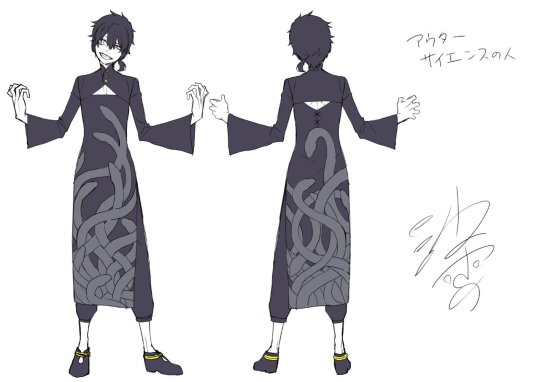
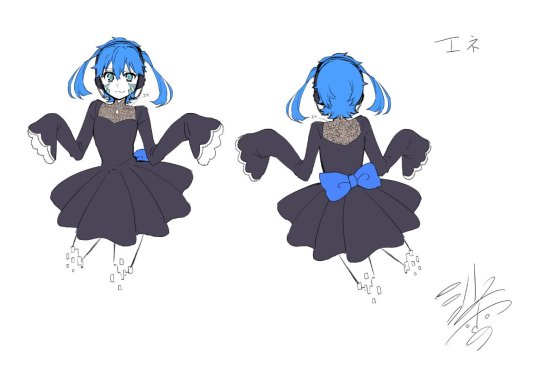
Kuroha and Ene's Design Poll outfits by Sayuki
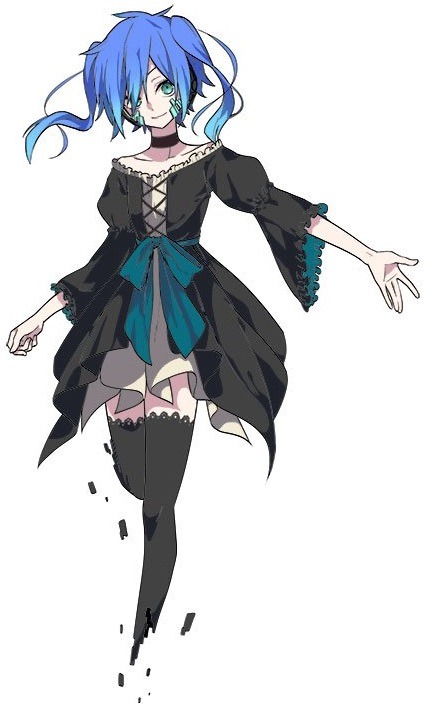

Ene's Seek at Mekakucity outfit by Satou Mahiro
I love Kuroha/Saeru's changshan inspired outfit by Sayuki 🖤💛
Ene's Seek at Mekakucity outfit is so pretty, I just knew I had to commission her in it 💙
You can read more under the cut if you're curious on the ideas that Feila and I came up with! We were coming up with ideas of what should be included in the commission.
We spent 3 days coming up with ideas and discussing the specifics (Themes, Background Elements, Ticket Info, etc.) before I sent the commission form.
Commission Rambles
This was the commission form I sent
Definitely the most detailed form I've ever written
I usually just describe the design details and poses and expressions, and then hand a Google Drive link of visual references. I included a folder of KuroEne's refs, and some photos of the flowers and gothic ballroom as inspiration
I just like to be detailed with my commission forms cuz I find it helps the artist



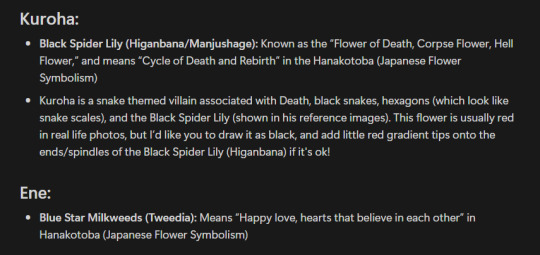

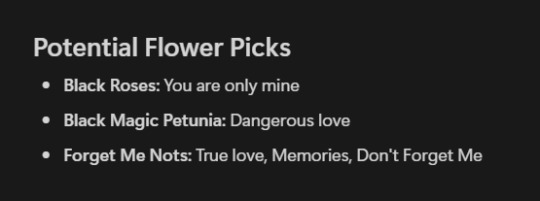
For the last SS, we drafted ideas for potential flowers, then narrowed it down to the two we chose. So we didn't include it in the final form
Feila mentioned that higanbana are also poisonous flowers... Fitting for a snake 🐍
Higanbana is PERFECT in symbolism for Kuroha/Saeru, especially since Awakening Eyes manifests as black snakes and aura spirals.
The Kagerou Daze VII -from the darkness- illust by Sidu draws him with black aura spirals that coincidentally look just like the spindles of higanbana.



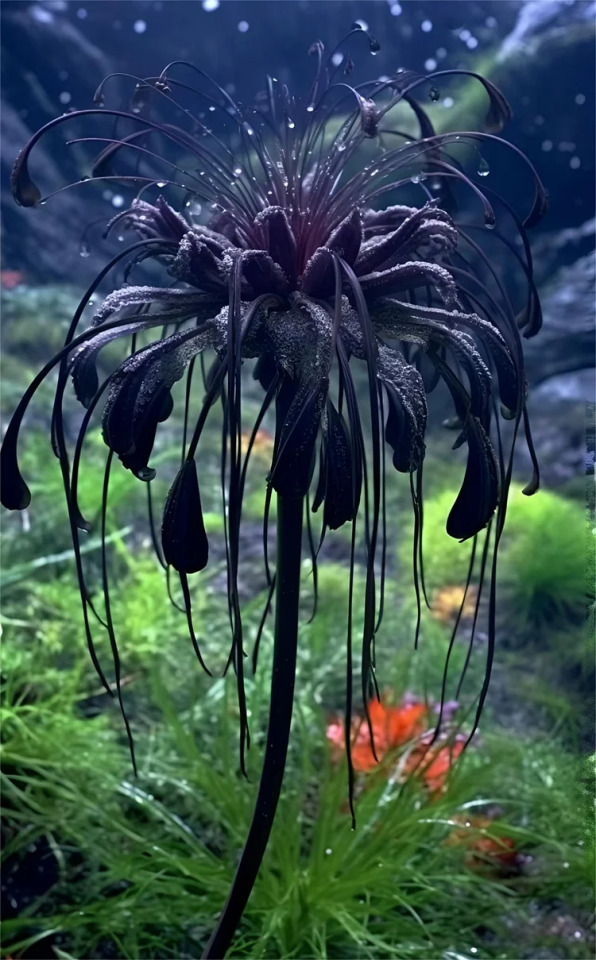
Blue Star Milkweeds and Red Higanbana
Black higanbana doesn't exist IRL, so it's just wilted red higanbana.
I haven't posted it yet, but I'm in the middle of writing a post on KuroEne and Flower Symbolisms (based on my own picks). I mentioned this more in depth there
I considered putting Snake of Clearing Eyes or Saeru, but I feel like KuroEne looks the best as a ship name so I went with that.
The comm form basically describes our ideas. I could talk about our ideas a lot more in detail eventually (but in a different post)
#kagerou project#kagepro#kuroha#ene#kgpr#kgpr fa#kagerou daze#mekakucity actors#enomoto takane#takane enomoto#kagerou days#ene kagepro#kuroha kagepro#black konoha#dark konoha#me ga saeru hebi#saeru hebi#saeru#kuroha x ene#kuroene#saeru x ene#saeene#clearing snake#snake of clearing eyes#other people's art#commission art#vgen#vgen comm
13 notes
·
View notes
Text
Tokyo Revengers but Mikey has the same coping mechanism as Sunny (Omori)
It's an incomplete post so anyone can add things if they want!
'Manjiro' will be used to talk about irl!Mikey while 'Mikey' will refer to Headspace!Mikey
Sanzu is called Haruchiyo and takes on Basil's role (aKa he's important but Mikey doesn't want to either make him tag along/a member of the party or to confine him on the picnic blanket)
'Sanzu' would be The Stranger
Takemichi also has The Stranger role (in timelines where he truly left an impression on Mikey - so probably not in the first two unfortunately)
Shinichiro and Emma both play Mari's role
-> Shinichiro & Takemichi being the only one to call Mikey Manjiro
Senju and Izana share a common role (in Bonten)
The party is made of Toman founding members
Baji, Kazutora, Pah-chin have a dynamic similar to Aubrey and Kel
Draken takes on Hero's role, Mitsuya too, a bit
Draken is the one who takes pictures!!! (like in canon :) )
-> "Did I take this photo? Something about it feels so familiar... No... Emma, she's-"
(Draken has little flags to make Mikey (or other party members) happy during fights)
(Mitsuya is the one who can cook)
Unbread Twins = Kawata Twins (with their ramen shop ofc, no bakery here)
other members are a bit scattered everywhere, mostly the playground ofc (which is a mix of: Toman's gathering place, the playground Baji&Mikey used to play in as children with a huge jungle gym), and the garden and dojo in the Sano house)
There's also the beach which can be reached mostly by Toman members
There's a train but they move around in motorbikes (and Mucho's car)
Motor shop to fix the bikes! Shinichiro can be found there with other BD members :)! (for some reasons, Mikey doesn't like it when Baji and Kazutora are there, so they have to find alternatives to fix their bikes (most of the time they ask another party member to take their bike))
Somehow, Manjiro subconsciously remember the story of Taiyaki-kun so there's a lake where Taiyaki-kun lives (he wants to leave but he can't :( )
It's the dreamworld so everyone is happy and has good relationships with everyone else
Somwhere there's a plane. It doesn't fly, but it's there, lying on the ground. It mustn't broke. (when it does, it leads to Blackspace) (Sanzu always tries to lead Mikey here)
Manjiro/Mikey don't fear a lot of things but things that may upset/trigger them are: mirrors/any type of reflection; whenever he sees a plane (won't make him go back to Whitespace but it's really close sometimes); (people needing to go to the) hospitals (no matter if it's bc they're sick or badly hurt) & probably other things but they don't come to mind sorry
Mikey's 'Something' is just.. everyone. They're all horrifying in a different way, but each person Mikey has failed haunts him (emphasis on Izana & Senju during Bonten)
The Somethings telling him 'I love you' in Blackspace 🥹
Important flowers would be black lilies (curse), and red and white spider lilies at the very end :) (Red spider lilies symbolizing the inability to meet again, farewell, death, loss, abandonment and White spider lilies symbolizing rebirth, meeting (anew), purity)
Also poppies since in Hanakotoba they can symbolize fun-loving and success, and in the more Western flower language they symbolize peaceful sleep and death, remembrance/remembering the fallen and renewal/resurrection among other things
(not a flower professional - just did some google researches so be careful with what I'm saying)
Whitespace:
Old blanket
NES (that he irl has in his bedroom and must hold a lot of memories of family/friends game night)
Mewo being replaced by Peke-j? But Mikey is not close to Peke-j(/not that close from Chifuyu (unlike other ppl)) from what we know. Peke-j could also be used as a way to show how guilty Manjiro is about Baji (and Chifuyu? Kazutora?)
moto figurines laying around? Little flags?
Probably wouldn't have a laptop
The journal+drawings stay tho. He deserves to vent
Deserves to keep the tissue box and cry, too
Blackspace:
Mikey goes in and out of it; he never chooses if he pops up in Whitespace, Dreamworld or Blackspace. It depends on how is his mind irl. There are also some places where he can directly enter it (ex: whenever the Concorde is broken)
Haruchiyo keeps dying. Or having his lower jaw removed out of nowhere (also happens in headspace -> leads Mikey to go back to Whitespace on the spot)
If we do put Peke-j in this AU as Mewo replacement, which choice do you think Mikey would make in the Cat dissection room with our dear mister the Cat Butler? /genuine
The three first timeline are very similar. Senju and Haruchiyo/Sanzu have a lesser role here. In the 3rd/Bad Toman, Kazutora is here and is hurt less by Mikey (whereas if he ever is present in the two firsts, Mikey won't be merciful)
Manila:
"You loved them and you killed them. You should just die." — hits more in this timeline than any other
Rather than Manjiro completely loosing against Mikey; there's a feeling of acceptance at the end of their fight from both parts. They can't go back, but they can't go further either.
Plus, Manjiro never fought for a will to live to start with
Actually I'm not sure if there'd be a fight to start with
Izana, S62 & Kakucho are not present in the headspace of this timeline
Bonten:
there's an entire space dedicated to Senju and Izana. It's filled with always-falling snow and everlasting sakura; the party can make snowmen and other snow constructions! There's a pond with a giant majestic beta fish somewhere, too (maybe it could interact with Taiyaki-kun, maybe not)
Edit: They live in a snow castle
those two are either safe in this place (*cough* until the snow and sakura start to get tainted by blood out of nowhere and they disappear and the flowers wilt *cough* The snow melts a bit under the warmth of blood and suddenly it's less a childhood joy and more just... Hellishly cold. bc the cold refuses to leave ofc *cough*) or with Shinichiro and Emma on the picnic blanket. Kakucho is always found around Izana so he can be found in the snow, too! (He's the one staying there when Izana & Senju disappear; he's panicking and extremely worried)
*cough* canonical Oyasumi ending *cough*
Timeline where the Somethings are the most troublesome and present
eat irl then go puke in the toilet
sleeps less and sleeps badly
Kanto Manji & Final timeline:
Still developing, mostly Whitespace
Mikey and Manjiro are not two different entities yet - Manjiro is not at that point where he suppresses all of his traumas when he's in the Dreamworld as Mikey
not a great emphasis on Senju since she doesn't die, but she's still there, having a lesser role
Draken, on the other hand- (it doesn't last long anyway since he travels back in time no long after)(I mean. it's still three months so maybe it's a bit long)
The "I have to tell you something"-timeline/ending, if there has to be one
#i wanted to have more ideas but they arent coming to me :'d#tr headcanons#tokrev hcs#tokrev headcanons#how do i tag this#tr mikey#mikey sano#tr manjiro#tokrev manjiro#manjiro sano#tokyo revengers#tr#tokrev#tok rev#bonten mikey#manila mikey#omori
34 notes
·
View notes
Text
I finally sat down to take a look at the flowers in the season 3 intro, and I found some,,,,INTERESTING things.
So first off, here's Reigen's card for reference:

(And let me just reiterate that I'm not a botanist or anything so there might be some misidentification on some of these, but correct me if I'm wrong on the flower types!)
The biggest ones on Reigen's eyes seem to be cranesbills, or wild geraniums. Specifically the ground cover variant as it has more stamens and blooms more in pinks than blues or purples. (Yes I did also consider cherry blossoms here, but the petals seem to be too small and too far apart for cherry blossoms. It could also be peach blossoms but the petals shape isn't right. Still, just in case; the most common meanings for cherry blossoms are love and "life is fleeting"). Cranesbills tend to symbolize loyalty and fidelity, as well as reliability and the ability to endure and adapt. In Victorian flower language though they sometimes represent folly and foolishness. RIP Reigen lmao. But pink geraniums themselves symbolize gentle affection and a growing love that has yet to be announced :)
With that in mind, I'm pretty sure the small cluster of pink flowers behind his ear are also geraniums instead of hydrangeas likes I originally thought—just of the more popular garden variety. Like he puts up a pretty front on the outside but inside is more gentle and less flashy :3
Now I THOUGHT I recognized the blue flowers as anemones, but their petal structure is different to the ones shown here so I'm much more unsure on this one. I'll add it in anyway though because I think it fits :)
"...blue anemone flowers are often associated with expectations and anticipation. They symbolize the promise of a brighter tomorrow and the hope for a better future. The blue anemone flower is believed to hold a special energy that can help lift your spirits and bring about feelings of joy and contentment.
...blue anemone flowers are thought to bring a sense of calm to those who are feeling anxious or overwhelmed. They are believed to offer protection and guidance during times of change and uncertainty.
...[they] are often used in meditation practices to enhance spiritual awareness and intuition. They are believed to help individuals connect with their inner selves and tap into their subconscious mind. The blue anemone flower is also associated with the throat chakra, which is believed to govern communication and self-expression." (source)
Now who does that sound like? 👀 There are a few other meanings there as well that fit, but another popular one is longing for your beloved and mourning. Another fun meaning in Reigen's picture specifically is that anemones close their petals when rainstorms approach; meaning that while the petals don't match exactly, it might very well be because they're closing. Like in anticipation for a storm :)
The little purple flowers ALSO seem to be half closed, which makes them that much harder to identify (• ▽ •;) I think they might be matsumoto asters given the color of them and the number of petals, but the size on the card is throwing me off a little. Still, in hanakotoba asters usually mean "I will not forget you", as well as being used frequently in memorials for the dead. In more European flower language asters represent the attraction of love, patience and wisdom, fidelity, charm, hope, valor, and farewell.
Then of course, the last two—the daisy and the rose. White roses symbolize innocence, silence, and devotion in hanakotoba. Sometimes they also symbolize death as they're also used in funerals and for mourning. The daisy however is also used in Mob's card, so I'll plonk that in here too and do that one first in between them :D
White daisies symbolize innocence, rebirth, and new beginnings. They've also been known to symbolize true love and loyalty. They're also part of the sunflower family!

As you can see above, Mob's card has quite a few more daisies than Reigen's, but I think that's because in season 3 the whole idea is centered around Mob's "rebirth", as it were. That, and in Victorian times it was popular for lovers to use daisies to send messages back and forth, and while an intact daisy means innocence, a daisy with a certain number of petals plucked is used to say either "love me" or "love me not". They're the origin of that ritual, apparently :3 Which is appropriate here because Mob's confession is essentially wondering whether or not Tsubomi will like him back—and the last flower in his bouquet that makes it out is a sunflower :) Which daisies are apart of :)
The flowers on Mob's eyes look like red chrysanthemums, but again considering the placement of the shadows in the middle I can't be completely sure. But while hanakotoba doesn't have a specific meaning for red chrysanthemums, white chrysanthemums and chrysanthemums in general mean honesty, royalty, and truth. In other flower languages, red chrysanthemums represent love at first sight, fidelity, and deep passion and emotions. It was also apparently a symbol for the Japanese emperor and imperial family, so do with that what you will.
On the left are a couple of hot pink roses, which symbolize gratitude and appreciation, as well as a sense of strength and conviction. And, something our boy Mob desperately needs: "Some believe that pink roses can facilitate emotional healing, encouraging forgiveness, self-love, and gratitude." 🙏
The ones on the bottom right are harder to see but I'm pretty sure they're daffodils, which have a lot of similar symbolism to daisies in that they're spring flowers that represent cheer, rebirth, and new beginnings. Daffodils also represent self-love/self-care in some cases though, because of the story of Narcissus. Something else our dear Mob desperately needs :') Though in hanakotoba, daffodils mainly represent deep respect, particularly for those older than you. Their japanese name also literally means "hermit by the water", which is,,,,,interesting.
Reigen seems to have more kinds of flowers than Mob, but Mob's flowers match his color scheme moreso than Reigen's do. I've said it before but it bears repeating; Reigen's flowers actually seem to follow Tsubomi's color scheme more than his own. The pink, the blue, the purple, the white... I don't know, I think it's interesting :3
If you've got any additions or corrections let me know!
#mobreimob#<- sacred wards#reigen arataka#kageyama shigeo#mob#flower language#mob psycho 100#flower symbolism
10 notes
·
View notes
Text
Ch198, Cover art flower language
@jack-littlecrow asks on this post what Sebastian's carrying in the cover art.

First off, Finny is carrying that decent-sized fir tree around like it's nothing, as expected of him. Germanic peoples were decorating such trees for Winter Solstice long before it became a Christmas tradition. To Pagans, such trees decorated with lights meant light after the dark, everlasting life, as well as fertility. To Christians, the decorated tree, particularly with lights, is symbolic of Jesus being a light in the dark world. It's also seen as a symbol of the Tree of Life in Eden.

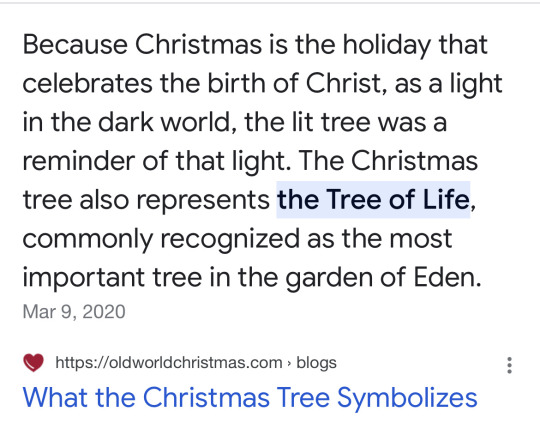
All the Christians had to do was ascribe that light in the dark to Jesus and make the everlasting life part of it harken back to the Book of Genesis.
What Sebastian is carrying was also used in an ancient Pagan tradition before it became a staple of Victorian winter-time decorations. It's not as popular now as the trees still are, but you will still see references to them, and some people still bring real or fake ones into their homes. It's also a type of evergreen, but of a very different nature.
Mistletoe.

In Victorian and other western flower languages, mistletoe is given meanings like these: love/romance, friendship, life/vitality, survival during hardship, wisdom, and even fertility.
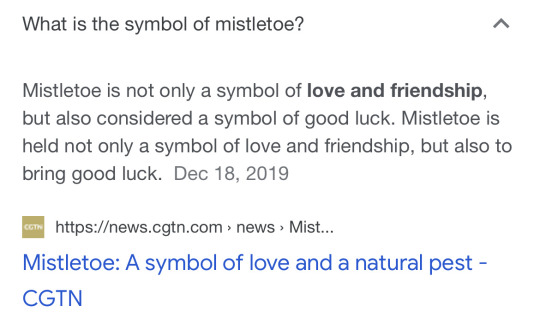
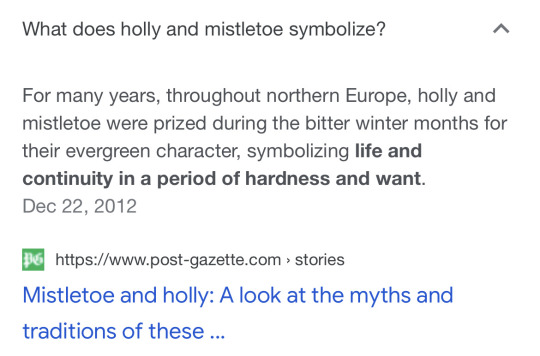

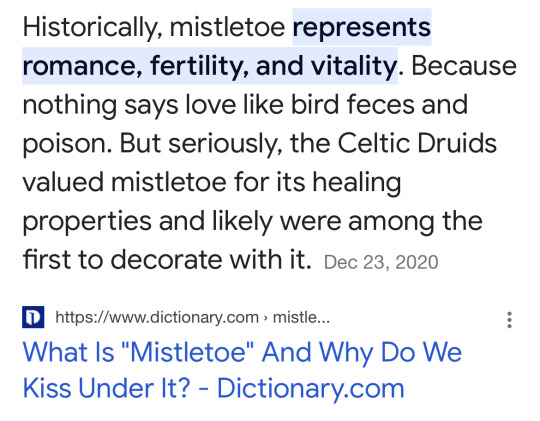
Hanakotoba, or Japanese flower language, gives similar meanings about love/romance and surmounting difficulties.

As a contracted demon, Sebastian is all about surmounting difficulties for his young master. And by this time, our earl's mere existence is a testament to survival during hardship.
But also keep in mind that mistletoe is a poisonous and parasitic plant.
So, the mistletoe emphasizes that Sebastian surmounts difficulties and provides our earl with continued survival during hardship... but he's essentially poison and a parasite.
#black butler#kuroshitsuji#ch198#flower language#victorian flower language#japanese flower language#flower symbolism#plant symbolism#mistletoe#fir tree#observation#analysis#hanakotoba#mar 17 2023
143 notes
·
View notes
Note
Why is it that demons are averse to wisteria? I have been trying to look into the meanings behind wisteria but I can only find what wisteria symbolises in European cultures. Is the relationship between demons and wisteria something that already exists in Japanese folklore, or something Gotoge decided, and if so, what might have been the reasoning/symbolism for choosing that particular plant over others?
AHA!!!! I knew I had written this up before, I just couldn't find it! I finally remembered that is was in my longer post theorizing that Muzan was from an offshoot of the Fujiwara clan! That wasn't exclusively about wisteria, but I'm copying-and-pasting here the long part that was, see below the cut. The Prof. Owada I refer to below is a retired Shizuoka University professor who wrote a book called “Japanese History of Demon Slayers” to directly capitalize on the success of Kimetsu no Yaiba, and to dive into a lot of ties between the series and what it may pay homage to throughout Japanese history and culture. It is not an official Shueisha publication and therefore not canon material, but it takes canon and fan theories into according pretty thoroughly. Since he's already done the breakdown of "why wisteria" I'm simply borrowing it. Short answer: No, this does not already exist in Japanese folklore and is unique to KnY. However, Gotouge usually has reasons for things and people love to ponder those reasons.
One such question is, why were wisteria lethal to demons? According to Prof. Owada’s research, there is no historical basis for this. Some of the talk online is that: 1. Wisteria are in fact poisonous, and consuming too much of them would cause vomiting and diarrhea (though I’ve also seen people make jam out of them because of the fragrance, so, like???) 2. Beans are thrown around at Setsubun to ward off demons (like so, Feat. Muzan and Kimetsu Beans), and wisteria are of the bean family 3. Wisteria like sunlight, so perhaps like Nichirin, they soak up some of the sun’s properties that are lethal to demons 4. In the language of flowers (Hanakotoba), wisteria symbolize kindness, welcomeness, refusing to leave someone’s side, being drunk with love, being straightforward and truthful, not losing the humanity in one’s heart, thereby containing a lot of meaning contrary to the conduct of demons Interesting, but some of its kind of a stretch. While still finding it a stretch to apply it to wisteria being poisonous to demons, Prof. Owada goes on to say that since ancient times, while the wisteria has some negative connotations of how it was sometimes written with characters meaning “doesn’t heal” (不治) and growing downward with smaller and smaller flowers like symbolize the slow downfall of a family line, it conversely also carries positive connotations of longevity and flourishing family due to the fact that its vines grow upward.
Now, you might picked up at some point that the Japanese word for wisteria is “fuji.” Not to be confused with Mt. Fuji (that’s written differently), it IS the same fuji as in “Fujiwara”: 藤.
Prof. Owada goes on to explore the association with the use of Wisteria crests in Kimetsu no Yaiba, especially on the houses of supporters of the Demon Slayer Corp. His recurring thesis is that the pandemic is partly responsible for Kimetsu no Yaiba’s popularity since demon legends have long since had origins in epidemics, and he supposes the Wisteria crest has a protective effect on the houses, similar to a talisman used in a lot of real life rituals for warding off illness and then often displays in or on the entries of houses to protect the family every year (I have one such item gifted to me, it stays by my doorway, along with a couple sticks of charcoal (but the culture of charcoal is a post for some other day)). The talisman is in reference to a god of Hindu/Chinese origins being treated with hospitality by the So clan, so although other families perished in disaster/disease, he promised to always protect the So clan descendants, so the talisman says “Descendants of the So Clan” so that any household may try to claim that divine protection. The gratitude-exchange of hospitality and protection and sure sounds familiar! Prof. Owada isn’t done yet. While the crest design used in Kimetsu no Yaiba isn’t an actual family crest in in real life, there are lots and lots and lots of family crests that use a wisteria design and have the character for “wisteria” in the name. Any time you hear “—tou”, like Satou, Saitou, or even Gotou, you can typically assume it’s 藤. It’s very common nowadays, but the first family to be granted the use of this name was the Fujiwara clan, when one of the pre-Heian and very powerful emperors granted their clan head this surname, which was a major honor, and it marked the start of the Fujiwara clan’s political dominance (there was already influence leading up to this, but meh, we like clear-cut stuff to simply centuries of history, don’t we?). Furthermore, although we often think of the Fujiwara clan for their influence at court, and we might think of the Minamoto clan for warrior heroes who fought demons, Prof. Owada concludes his argument of wisteria’s protective influence by pointed out a long list of Heian period Fujiwara warriors who also were the heroes of demon slaying legends, stating that their name has also long been tied with demon slayer culture.
61 notes
·
View notes